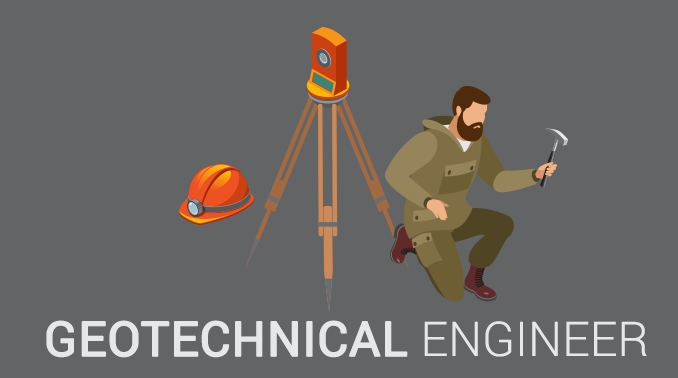9 Easy Facts About Geotheta Described
Table of Contents3 Easy Facts About Geotheta ExplainedFascination About GeothetaGeotheta for BeginnersSome Known Questions About Geotheta.
They collaborate with civil designers, architectural engineers, engineers, and various other professionals to incorporate geotechnical factors to consider right into the total job style and building process. This calls for reliable synergy, sychronisation, and communication to guarantee that the geotechnical facets straighten with the job goals and satisfy regulative requirements.Mining & Materials Design: Principles of boring, infiltration rates, and aspects impacting the option of exploration method. Blasting methods in surface and underground operations. Mechanical and continual methods to fragmentation, consisting of longwall shearing and fullface boring.
Integrated evaluation of fragmentation and comminution procedures. Supplied by: Mining & Products Engineering.
The Best Strategy To Use For Geotheta
Bachelor's level programs in civil, geotechnical, geological, and environmental engineering generally last 4 years and consist of general education and learning programs in English, social scientific research, and the liberal arts, as well as courses in sophisticated maths, architectural geology, and liquid mineralogy. (https://slides.com/geotheta)
Geotechnical engineering entails the assessment of the soil and rock problems at a certain website, and their implications for the advancement of that website. As the majority of structures count on the ground for support, it is without surprise that an in-depth understanding of the ground problems, and the viability of foundation systems, are vital to the long-term stability and performance of the building or structure.
Specialising in the investigation of geological formations and ground practices, geotechnical engineers perform scientific examinations and screening to comprehend the impact these geological formations might carry the layout and building of building, civil and framework tasks. This knowledge is critical for the design and building of buildings, roads, passages, dams, bridges, and water and sewer systems.
The geotechnical team at Douglas Allies regularly consult with designers, design engineers, designers, and contractors to make suggestions on design and advancement propositions to guarantee that the built structures are appropriately developed for the ground conditions. For example, the layout of footing systems needs to consider the weight of the framework, the capacity of the ground to support that weight along with motion resistances and efficient building and construction.
Some Of Geotheta
This job is considerably simplified by the use our Douglas Map geospatial system which makes this details readily obtainable in a simple to use internet internet browser user interface. A geotechnical engineer will certainly direct the boring of boreholes and examination pits to accumulate soil and other examples, and also examine surface area features and ground exposures to develop a geotechnical design of the subsurface conditions.
Depending upon the task kind and ground conditions came across, research laboratory testing may amongst other points analyze strength, compressibility, sensitivity and/or leaks in the structure of dirt and rock examples. After this data is collected and collected, the results are used for a geotechnical model of the site, which is typically presented as sections across the site.

A geotechnical examination naturally can just analyze the ground problems at the areas drilled or dug deep into. All-natural variations in dirt and rock problems can happen throughout a website and in between examination areas. It is therefore good practice that the geotechnical designer be maintained throughout building of the job to give on-site verification that the ground conditions experienced follow the assumptions and advice provided in the geotechnical examination record.
Not known Details About Geotheta
Geotechnical engineers utilize their extensive knowledge of soil and rock to analyze risk and address troubles on diverse infrastructure projectsGeotechnical engineering is a specialist branch of civil design which takes a look at the behavior of planet products and the application of soil and rock auto mechanics. Consulting Engineer. As a geotechnical engineer, you will certainly assess the physical, mechanical and chemical residential properties of dirt and rock in order to design foundations, keeping structures and earthworks
Geotechnical design is very closely connected to and overlaps with, both engineering geology and ground design - https://soundcloud.com/geotheta. It's feasible to specialise in geotechnics or job for a geotechnical business yet be called an engineering geologist or a ground engineer. As a geotechnical designer, you'll need to: construct and maintain relationships with clients and various other professionals associated with the site, throughout each projectmaintain safety standards on site bear in mind price effects when you make recommendationsstudy geological maps and aerial photos from a variety of sources and from various time periodsexamine building plans to see exactly how practical they are based on your understanding of the siteinvestigate threats or geological threats for the sitesearch for environmentally sensitive features, such as land fill begin to establish accurate and expository ground modelsplan field investigationsdrill and analyse samples of bedrock, dirt, groundwater and extra products manage other specialists on sitesolve technological concerns as they emerge, such as unexpected frameworks at drill sitesmonitor conditions during and after construction to make certain frameworks are stable in the short and long termadding data accumulated on site to your initial researchcreating geotechnical estimations, illustrations, and 2 or three-dimensional computer system versions interpreting the datamaking suggestions regarding the suggested use the site
